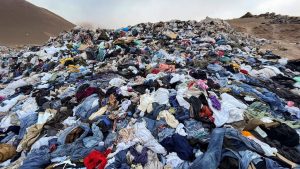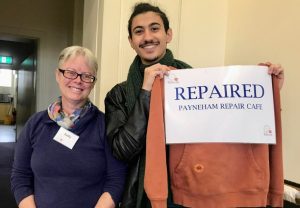Australia has a problem with fast fashion. The rise of companies such as Temu and Shein have created a situation where people are buying clothes and disposing of them, sometimes unworn, because they are so cheap. This causes a multitude of problems:

Piles of unwanted clothes in Atacama Desert, Chile (credit: https://phys.org/)
- Greenhouse gases are emitted as textiles break down in landfill.
- The chemicals and toxins that leach out of textiles in landfill can contaminate groundwater.
- They take a long time to break down! 100s of years for synthetic fibres, and don’t forget about the zips and buttons and other closures.
- The tonnes of textiles take up so much space.
- Emissions are still generated in the production of garments that are disposed of without even being worn, and then there’s the water and human cost. Did you know that it takes 2700L of water to manufacture a single cotton t-shirt? (This is likened to the tonnes of food waste which is thrown out uneaten each year…but that’s another story!)
As a result of the environmental and economic issues being caused by fast fashion, France (known for its haute couture) feels that the issue is impacting its global reputation as a purveyor of quality luxury goods, and has cracked down on the fast fashion trend by voting to install a fee per item that will hopefully dissuade retailers from pursuing these lines of ultra-cheap clothing. The new bill will also crack down on advertising algorithms in social media, and producers will be required to inform consumers of the environmental impacts of their products.

Tanya Plibersek cracking down (credit: Australian Fashion Council)
As part of Australia’s reputation for environmental action (cough), the Hon. Tanya Plibersek, Minister for the Environment, has jumped on board by beginning to regulate the industry in Australia. In a speech to the eBay Circular Fashion Fund in February she promised to crack down on the responsibilities of both the fashion industry, to be more transparent in their production processes, and consumers, to be more aware of their purchasing power and engage in more sustainable behaviour.
Importantly, an increased focus on better design and responsible materials, has led to the Australian Fashion Council creating the Clothing Stewardship Scheme called Seamless which was launched last year. The goal is to transition the fashion and textile industry into sustainable circularity by 2030, and if industry leaders don’t voluntarily onboard, then the Minister says she will mandate the scheme.
Seamless is a good start and it’s great to see the Australian fashion industry taking these steps to create a more sustainable future for the industry. We, as consumers, also need to put pressure on manufacturers to be more transparent in their supply chain and manufacturing processes, and to provide us with the options we need, whether that’s sustainably farmed fibres, or locally produced garments, tutorials on how to maintain our clothing, better end-of-life product options (ie textile recycling), or a lifetime warranty on manufacturing faults. Planned obsolescence should be a thing of the past, in clothing as in other products, and garments should be manufactured to last longer.
It’s not enough anymore to say, “I take my used clothes to the op shop”. These clothes can still end up in landfill, or worse, creating more emissions to be shipped overseas for their second-hand clothing market and then ending up in landfill.
You as a clothing purchaser can create change by not just chasing that shopping endorphin high, but conscientiously choosing well-made quality products that will last for years rather than a season. The Minister is advocating for the circular economy. She recommends regifting, repurposing, repairing, clothes swaps, or rentals…anything to avoid the throwaway culture that has become the norm in Australia, and globally. The more textile waste that we can keep out of landfill, the fewer emissions are generated.

Clothing repairs at a Repair Cafe (credit: Payneham Repair Cafe)
If you have clothing that you no longer want, consider:
• Clothes libraries, or
• Op shops (vintage and consignment)
If you want to change up your wardrobe without contributing emissions, consider:
• Clothes rentals
If your garments need some TLC but you still love them, consider:
• Repair Cafes
• Repair tutorials
If they are beyond repairing, consider:
• Textile recycling
In Australia, we are excellent innovators. Scientists are always working on ways to recycle textiles and garments. The fashion industry is beginning to catch on and R&D departments everywhere are investing in sustainable practices and driving towards net zero. If you are a producer, a manufacturer, a retailer, or an innovator, and are working towards net zero, get in touch to see if we can help you model a net zero pathway specific to your organisation or industry.
